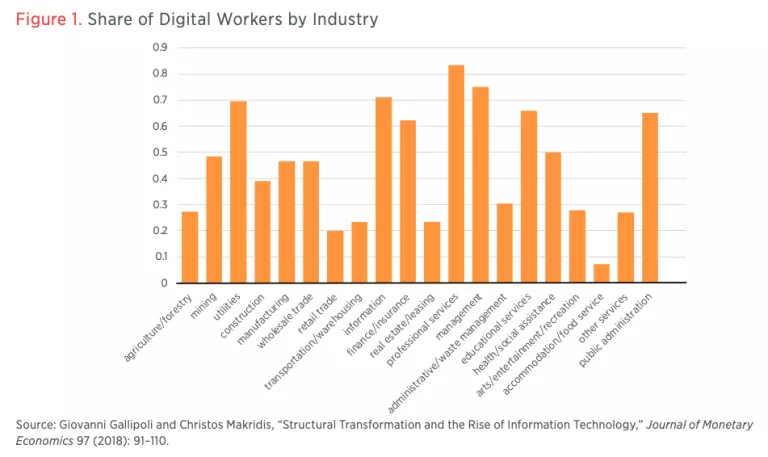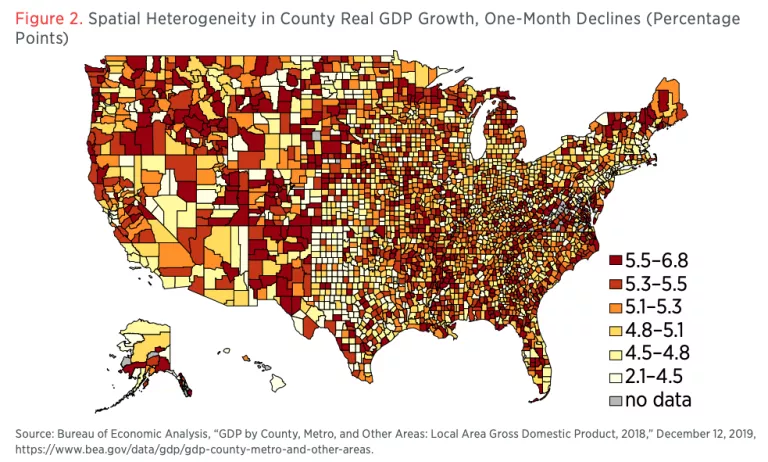- | Government Spending Government Spending
- | Policy Briefs Policy Briefs
- |
The Cost of COVID-19: A Rough Estimate of the 2020 US GDP Impact
It will be a while before traditional macroeconomic indicators provide meaningful information about the magnitude of the economic slowdown owing to the novel coronavirus. The mitigation measures adopted—a partial economic shutdown and social distancing—will exact a heavy cost on society that is not yet known.
In order to fill this information gap, we provide here a back-of-the-envelope estimate of the impact of current mitigation measures on the 2020 GDP growth rate. That impact varies by industry, and we are able to identify this variation by adopting a simple but plausible assumption: industries will remain in business in proportion to their degree of digitalization. To measure digitalization, we use the share of information-technology-intensive workers in a given industry relative to the industry’s total workforce.
Furthermore, our granular dataset is broken down at the level of industrial activity within counties, which allows us to make GDP forecasts at the county level.
We estimate that the real GDP growth rate will decline 5 percent for each month of partial economic shutdown. Therefore, the economic cost of the first two months spent fighting the pandemic will be $2.14 trillion (10 percent), which is surprisingly close to the static fiscal cost of the CARES Act.
Estimation: Data, Methods, Results
Our estimates are based on recently released data on real GDP (at 2012 prices) between 2000 and 2018 from the Bureau of Economic Analysis. Rather than classifying certain industries as “directly affected” by COVID-19, we use the digital-labor intensity of each industry to quantify the varying effect across industries. That intensity level is the share of digital workers within each industry derived from information on tasks at an occupational level from the Department of Labor’s O*NET database (see figure 1).
Our key assumption is that industries will remain productive in direct proportion to their degree of digitalization because at least that portion of their workforce can continue working from home and contribute services that do not depend as much on in-person interactions.
First, we estimate the 2019 real GDP since these data have not yet been made available at the county level. For simplicity, we use the 2001–2018 trend for each county and industry pair. Second, we forecast 2020 GDP by discounting a monthly penalty on each county’s growth rate. The penalty is inversely proportional to the degree of digitalization, and it is applied to one-twelfth of the annual growth rate for each month of partial shutdown.
Take two industries, one with a high intensity (two-thirds) of digital workers in its labor force and the other with a low intensity (one-third). The one-month partial shutdown means we apply a penalty to the 2020 GDP of 2.78 percent (1/12 × [1 − 2/3]) for the first industry and 5.56 percent (1/12 × [1 − 1/3]) for the second. This penalty translates into a lower growth rate for the latter low-digitalization industries than the expected growth without the pandemic; if the expected growth rate were 2 percent, then a one-month shutdown means the first industry would shrink a little (−0.78 percent = 2 − 2.78), and the second industry would shrink a lot (−3.56 percent = 2 − 5.56).

Under these assumptions, we estimate a 5 percent decline in real GDP growth for every one month of partial economic shutdown. Thus, the economic cost of two months of mitigation measures is $2.14 trillion (10 percent).
We also examine the cross-sectional relationship between declines in county GDP and various county characteristics: median income, college attainment, and participation in international commerce (tradable sector). We observe that counties with higher shares of digital workers are less affected by the pandemic, reflecting our assumption that industries in which employees can work from home suffer less disruption.
Second, counties with lower median household income are likely to be more adversely affected, in principle, because they have fewer digital jobs. Third, counties with lower shares of college-educated individuals are also more likely to experience greater economic declines, which reflects the fact that jobs requiring a college degree are likely more digitally intensive. Fourth, and not surprisingly, we find that counties with a larger share of workers in nontradable sectors are also more heavily affected because those sectors are less diversified and more exposed to local shocks.
For a visual county-to-county comparison, we offer a heat map that shows our estimate of penalties on growth for each county (figure 2).

Limitations and Robustness
We made a few important simplifying assumptions. First, we did not model substitution between brick-and-mortar and online goods and services. Second, we did not account for intersectoral linkages and nonlinearities, which have been important in understanding historical business cycles. For example, declines in employment among food and hospitality sectors may lead to lower real incomes for workers in those industries, who in turn will have less to spend on other goods and services in the arts, entertainment, or even manufacturing sectors. These complementarities could deepen the downturn that we estimated.
Third, our approach does not account for the compounding effect over time of mitigating measures. By at least one estimate, one year of severe social distancing may be required to avoid the most troubling public-health consequences of the pandemic and reduce the probability of a second wave. If the partial economic shutdown extends beyond two months, we foresee the need to adjust our estimate for the multiplier effect of delayed investments of physical and human capital.
For all those reasons, our estimate is conservative and could be considered the upper bound of estimates of the slowdown. Although we could be quantifying the most optimistic scenario, our estimates are consistent with estimates of the effect of the influenza pandemic of 1918 and with other contemporary estimates.
In 1918, influenza decimated 2 percent of the world population and led to a 6 percent shrinking of GDP and an 8 percent decline in consumption, in line with our estimate for a two-month shutdown. Other estimates are even more severe, predicting as much as 18 percent shrinking of manufacturing output. Goldman Sachs estimates an annualized 9 percent decline in real GDP in Q1 of 2020 and an annualized 34 percent decline in Q2 owing to the COVID-19 pandemic, comprising a deannualized total COVID-19 impact on GDP of more than 10 percent. A direr economic forecast of the effects of the lockdown estimates that there could be an annualized 10 percent decline in real GPD in Q1 of 2020 and an annualized 63 percent decline in Q2, comprising a deannualized total COVID-19 impact on GDP of approximately 25 percent. Moreover, these effects are unevenly distributed across sectors; for example, consumption on restaurant spending fell by a third, whereas credit-card and grocery spending increased significantly.
One strength of our estimate is that we are adding geographical granularity that could be important when authorities seek to modulate the intensity of mitigation measures to the needs of individual counties.
Triangulating to Inform Policy
Our estimates provide a baseline for comparisons in dynamic models with heterogeneous agents. For example, supply-side shocks such as a pandemic lead to a differentiated decline in demand that, once adequately accounted for by a multisector model, finds more modest effects in government stimulus of demand than those usually obtained with a single-sector model.
Once macro data is available, standard macroeconomic models will estimate with greater precision the effect of the mitigation shutdown. But alternative data sources could more quickly refine early estimates such as ours. For example, data on online reviews (e.g., Yelp) or online food delivery (e.g., Caviar) could provide the utilization rate of the food services sector, as well as a way of gauging economic activity in real time. Moreover, these data could help policymakers understand the degree of substitutability between brick-and-mortar and online services, as well as the longer-run effects of uncertainty on investment and hiring.
Our early estimates and future improvements and refinements could help with the management of this crisis. In order to relax the strict mitigation regime currently in force, policymakers need data on the social costs and benefits of those measures, and our analysis provides an approximation of the cost part of that equation. Used in combination with county data on infections—hospitalizations, recovery, and mortality rates—our estimates could help inform a mitigation strategy that differentiates across regions.
About the Authors
Christos A. Makridis is an assistant research professor at the W. P. Carey School of Business at Arizona State University, a digital fellow at the Sloan School of Management at MIT, a nonresident fellow at the Kennedy School of Government at Harvard University, and a nonresident fellow at the Institute for Religious Studies at Baylor University. Makridis also serves as a senior adviser with Gallup. His research focuses on the areas of labor and organizational economics, the digital economy and cybersecurity, and household finance and well-being, with a driving commitment to understanding how individuals and firms respond to large-scale change, particularly social and technological. Makridis earned his doctorates in management science and engineering and economics at Stanford University and his undergraduate degrees in economics and mathematics at Arizona State University.
Jonathan S. Hartley is an economics writer and researcher with interests in macroeconomics, finance, and sports analytics. He has previously worked at Goldman Sachs Asset Management as a Fixed Income Portfolio Construction and Risk Management Associate and as a Quantitative Investment Strategies Client Portfolio Management Senior Analyst. He has also worked in various government roles at the US Congress Joint Economic Committee, the Federal Reserve Bank of New York, and the Federal Reserve Bank of Chicago. Hartley graduated from University of Chicago with a BA in economics and mathematics with honors, and from the Wharton School at the University of Pennsylvania with an MBA specializing in finance and business economics. He is also an MPP candidate at the Harvard Kennedy School.

